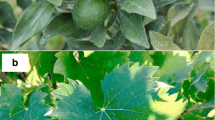Abstract
Paraquat-resistant biotypes of the closely-related weed species Hordeum leporinum Link and H. glaucum Steud. are highly resistant to paraquat when grown during the normal winter growing season. However, when grown and treated with paraquat in summer, these biotypes are markedly less resistant to paraquat. This reduced resistance to paraquat in summer is primarily a result of increased temperature following herbicide treatment. The mechanism governing this decrease in resistance at high temperature was examined in H. leporinum. No differences were observed between susceptible and resistant biotypes in the interaction of paraquat with isolated thylakoids when assayed at 15, 25, or 35 °C. About 98 and 65% of applied paraquat was absorbed through the leaf cuticle of both biotypes at 15 and 30 °C, respectively. Following application to leaves, more herbicide was translocated in a basipetal direction in the susceptible biotype compared to the resistant biotype at 15 °C. However, at 30 °C more paraquat was translocated in a basipetal direction in the resistant biotype. Photosynthetic activity of young leaf tissue from within the leaf sheath which had not been directly exposed to paraquat was measured 24 h after treatment of plants with para. quat. This activity was inhibited in the susceptible biotype when plants were maintained at either 15 °C or 30 °C after treatment. In contrast, photosynthetic activity of such tissue of the resistant biotype was not inhibited when plants were maintained at 15 °C after treatment, but was inhibited at 30 °C. The mechanism of resistance in this biotype of H. leporinum correlates with decreased translocation of paraquat and decreased penetration to the active site. This mechanism is temperature sensitive and breaks down at higher temperatures.
Similar content being viewed by others
References
Arnon, D.I. (1949) Copper enzymes in isolated chloroplasts. Polyphenoloxidase in Beta vulgaris. Plant Physiol. 24, 1–15
Baldwin, B.C. (1963) Translocation of diquat in plants. Nature 198, 872–873
Bishop, T., Powles, S.B., Cornic, G. (1987) Mechanism of paraquat resistance in Hordeum glaucum. II. Paraquat uptake and translocation. Aust. J. Plant Physiol. 14, 539–547
Brian, R.C. (1967) Darkness and the activity of diquat and paraquat on tomato, broad bean and sugar beet. Ann. Appl. Biol. 60, 77–85
Brian, R.C. (1969) The influence of darkness on the uptake and movement of diquat and paraquat in tomatoes, sugar beet and potatoes. Ann. Appl. Biol. 63, 117–126
Calderbank, A., Slade, P. (1976) Paraquat and diquat. In: Herbicides: chemistry, degradation and mode of action, vol 2, pp. 501–540, Kearney, P.C., Kaufman, D.D., eds. Marcel Dekker, Inc., New York
Mees, G.C. (1960) Experiments on the herbicidal action of 1,1′-ethylene-2,2′-dipyridylium dibromide. Ann. Appl. Biol. 48, 601–612
Powles, S.B. (1986) Appearance of a biotype of the weed, Hordeum glaucum Steud., resistant to the herbicide paraquat. Weed Res. 26, 167–172
Powles, S.B., Cornic, G. (1987) Mechanism of paraquat resistance in Hordeum glaucum. I. Studies with isolated organelles and enzymes. Aust. J. Plant Physiol. 14, 81–89
Preston, C. (1994) Resistance to photosystem I disrupting herbicides. In: Herbicide resistance: biology and biochemistry, pp. 61–82, Powles, S. B., Holtum, J.A.M., eds. Lewis Publishers Inc., Boca Raton, Fla
Preston, C., Holtum, J.A.M., Powles, S.B. (1992) On the mechanism of resistance to paraquat in Hordeum glaucum and H. leporinum. Delayed inhibition of photosynthetic O2 evolution after paraquat application. Plant Physiol. 100, 630–636
Slade, P., Bell, E.G. (1966) The movement of paraquat in plants. Weed Res. 6, 267–274
Smith, J.M., Sagar, G.R. (1966) A re-examination of the influence of light and darkness on the long-distance transport of diquat in Lycopersicon esculentum Mill. Weed Res. 6, 314–321
Tucker, E.S., Powles, S.B. (1991) A biotype of hare barley (Hordeum leporinum) resistant to paraquat and diquat. Weed Sci. 39, 159–162
Author information
Authors and Affiliations
Additional information
We are grateful to Zeneca Agrochemicals, Jealotts Hill, Berkshire, UK who provided [14C]paraquat. E.P. was supported through a Ph.D. scholarship from the Australian International Development Assistance Bureau and C.P. was the recipient of an Australian Research Council Postdoctoral Fellowship.
Rights and permissions
About this article
Cite this article
Purba, E., Preston, C. & Powles, S.B. The mechanism of resistance to paraquat is strongly temperature dependent in resistant Hordeum leporinum Link and H. glaucum Steud.. Planta 196, 464–468 (1995). https://doi.org/10.1007/BF00203645
Received:
Accepted:
Issue Date:
DOI: https://doi.org/10.1007/BF00203645




